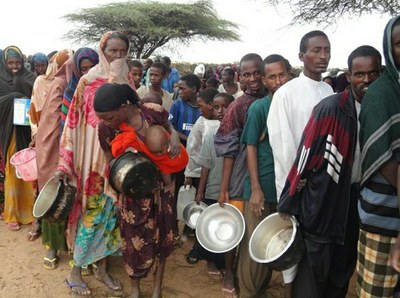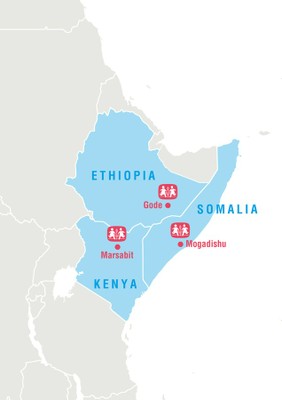East Africa Famine: Somalia caught between hunger and crossfire

- Families wait in line for food in one of Mogadishu's refugee camps
Following the worst drought in East Africa in years, we are working with thousands of families who are now residing in refugee camps in the capital city of Mogadishu.
Somalia worst hit
East Africa is experiencing the worst drought in 60 years, with more than ten million people threatened by starvation in four countries - Somalia, Ethiopia, Kenya and Djibouti.
Somalia has been the country hardest hit, with the UN declaring a famine in its Bakool and Lower Shabelle regions. After two decades of non-stop fighting, many of Somalia's population do not only face severe food shortages, but the constant threat of violence and conflict.
Desperate to survive, thousands of drought-affected families from all over the Bay and Bakool regions in central Somalia have moved south to the dangerous city of Mogadishu in search of food and medical care. Nearly 50,000 displaced people are now living in this area, primarily in two large refugee camps on the outskirts of the city. It is estimated that 1,000 children and families arrive in Mogadishu every day – many have travelled for days, if not weeks, and are severely malnourished.
SOS Children have established a mobile medical clinic as well as a feeding centre for children and families in Mogadishu’s biggest settlement, the Badbado Camp (in the Dharkenley area). According to government officials, between 5,000 to 6,000 families displaced by the drought are residing in the camp. Qualified SOS doctors and nurses have already given medical assistance to 1,330 children and families, most of whom are in desperate need of medical assistance.
Children are severely malnourished
It is estimated that 640,000 children in Somlia are acutely malnourished, and 1.26 million in need of urgent medical attention.
Ahmed Ibrahim, Director of SOS Children's Villages Somalia, recently visited the camp, "Most of the children and older people are malnourished," he said. “Men, women and children all stand in line together and receive the same: rice."
Many of the families come from regions that have been inaccessible for the past two years because of the war. This has meant that many children have not been immunized, placing them at great risk to a measles epidemic, as well as diarrhoea, respiratory infections and malaria. The mobile clinic in
the camp will provide specialist mother and child health services, treat
patients with common diseases and provide essential drugs. We have also established an immunisation centre which will provide
free vaccinations to protect as many children as possible.
The feeding centre has so far admitted 149 severely malnourished children, and staff are working to increase the capacity so that even more children can be attended to. Milk has been airlfted from Kenya in an effort to make sure that the centre has plenty of nutritional supplies.
We are also working in the rebel-controlled city of Baidoa, you can read about our relief efforts here.
Dangerous work
SOS Children have been working in Somalia since 1985. As well as providing long-term family-based care for orphaned and abandoned children in the capital Mogadishu, a hospital provides medical care for 30,000 patients every year. An SOS Children Mother and Child Clinic remains the only functioning maternity ward and gynaecological care facility in the country.
Fighting has badly affected SOS Children families and staff throughout the years and several staff have died after being hit with stray bullets and mortars. However, SOS Children has remained in Somalia and has been one of the very few NGOs to run a comprehensive social programme in the county.
 Help for Ethiopia and Kenya
Help for Ethiopia and Kenya
SOS Children will also be setting up an Emergency Relief Programme in Southern Ethiopia. In the past decades, SOS Children has repeatedly provided disaster relief in Gode and other regions of Ethiopia because of recurrent droughts. Gode lies in one of the driest areas of Ethiopia. Thanks to the existing infrastructure and expertise of SOS Children staff, we are able to provide relief aid in this location and will distribute food and put sustainable development measures in place to secure families' survival in the long-term. SOS Children currently supports 59,000 people in Ethiopia.
In Kenya, we plan to provide food to five vulnerable communities of Marsabit by providing communities with drinking water, providing medical supplies and by setting up a feeding programme targeting severely malnourished children.
Below, you can watch a video from Dijbouti which highlights the dramatic need in drought-stricken areas:
How you can help
You can make a one-off donation directly to our Emergency Relief Programme in Somalia, or take out a child sponsorship to help us to focus on the long-term welfare of children who have no one to care for them as a result of the famine.

 Return to Schools Wikipedia Home page…
Return to Schools Wikipedia Home page…
